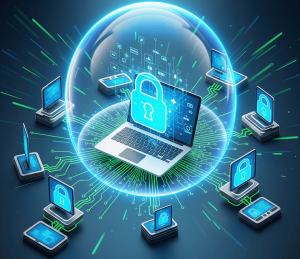Introduction
Cyberattacks in 2025 don’t just target online accounts or cloud services—they target your physical devices too. Laptops, smartphones, and home networks are all entry points hackers exploit to steal data, monitor activity, or deploy malware. True cybersecurity begins at the root: your devices and the systems that power them. In this comprehensive guide, we’ll walk you through the best practices to secure your computer, smartphone, and home network—ensuring a strong foundation for your digital safety.
Why Device and System Security is Fundamental for Cybersecurity
Devices as Primary Entry Points
Hackers often use malware, phishing, or unauthorized access to gain control of devices. Once inside, they can bypass layers of software protection, access sensitive files, or even spy through webcams and microphones.
Device Security and Data Privacy
Your privacy is only as strong as the device that holds your data. Even with encrypted cloud services, a compromised device can leak information, expose credentials, or allow persistent tracking.
The Importance of System Updates
Operating systems and apps are regularly updated to patch security vulnerabilities. Failing to apply these updates leaves your system exposed to known exploits that cybercriminals actively target.
Securing Your Computer (Windows & macOS)
Keep Your OS and Software Up to Date
Enable automatic updates for your operating system and critical applications. This ensures you receive the latest security patches and bug fixes without delay.
Use a Firewall
Activate your built-in firewall (Windows Defender Firewall or macOS Firewall). For extra protection, consider using third-party firewalls with enhanced filtering capabilities.
Manage User Accounts Wisely
Avoid using administrator accounts for everyday tasks. Set up a standard user account for daily use to limit potential damage in case of compromise.
Regular Backups
Back up important data both locally (external hard drives) and via cloud services. Use automated backup tools and verify backups regularly.
Enable Full Disk Encryption
Use BitLocker on Windows or FileVault on macOS to encrypt your entire drive. This protects your data if the device is lost or stolen.
Protecting Your Smartphone (Android & iOS)
Secure Lock Screen
Always use a strong passcode, fingerprint, or facial recognition. Avoid simple patterns or codes that are easy to guess.
Keep OS and Apps Updated
Install security updates as soon as they become available. App vulnerabilities are common attack vectors on mobile platforms.
Manage App Permissions
Review app permissions regularly and revoke access to unnecessary features like location, contacts, and microphone.
Download Only from Trusted Sources
Use Google Play or the Apple App Store. Avoid installing apps from third-party stores or unknown sources, which are more likely to contain malware.
Use Device Tracking Features
Enable “Find My Device” (Android) or “Find My iPhone” (iOS). These tools let you locate, lock, or erase your phone remotely if it’s lost or stolen.
Securing Your Home Network & Smart Devices
Router Security
Change the default admin credentials. Use strong, unique passwords and enable WPA3 or WPA2 encryption for Wi-Fi. Update router firmware regularly.
Smart Device Management
Many smart devices ship with weak default settings. Change factory passwords, disable unnecessary features, and regularly check for firmware updates.
Disconnect Unused Devices
Unplug or disable smart devices you don’t actively use. Fewer connected devices mean fewer potential attack surfaces.
Create a Guest Network
Set up a separate Wi-Fi network for visitors. This keeps your main devices and personal data isolated from potentially unsecured guest devices.
Conclusion
Cybersecurity starts with you—and with your devices. Securing your computer, smartphone, and home network is the first step toward a stronger, more resilient digital life. By following the steps in this guide, you can reduce your exposure to threats and take charge of your digital safety in 2025.
Have a question or tip to share? Leave a comment or connect with us—we’re here to help you stay secure.
